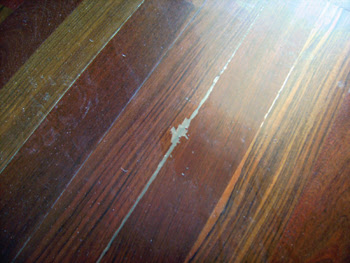White Line Syndrome Explainedby Katie Knight |
Many flooring pros see white line syndrome at some point in their careers.
Often we hear about it in waves. One year, we'll get just one complaint, the next it'll seem like every other installer is fighting white line syndrome.

White line syndrome is a common and often misunderstood wood floor issue. Keep reading to learn why it happens, how to prevent it, and how to treat white line syndrome.
Why does white line syndrome happen?
Usually, we see white line syndrome in the spring after a dry, cold winter. Fluctuations in seasonal humidity and temperature cause the floor and finish to expand.
Floors with white lines typically start out at the right moisture content, then get dry in the winter. As the humidity increases in the spring, the finish stretches or lifts, creating obvious white lines between every single board.
If the humidity doesn't change as much (often because of a well-maintained home environment or inconsistently dry areas of the country), white lines usually won't appear.
White line syndrome happens because the floor moves - which is usually caused by seasonal or extreme environmental conditions. Although there can be problems during the finishing process, It's not often a finish or application failure.
How can I prevent white line syndrome on wood floors?
We've found two helpful articles that explain the causes and solutions for white line syndrome. Every situation will be different, so accurately diagnosing what is going on is important to prevent it later.

White line syndrome is more pronounced on dark floors. Additionally, wide plank floors are more susceptible than narrower floors. Even so, white lines can be prevented with 4 steps.
Ben Totta with Totta Hardwoods in Kansas City writes about his experience with white lines and provides 4 steps to prevent them.
He suggests learning about what finish is right for each situation:
There’s no such thing as a perfect finish product or type of finish. They all have their pros and cons and place. Educate yourself on when they will perform well, and confidently educate your customers.One of the most common types of white line syndrome is caused by peeling finish. This occurs along the board's edges. But not all white lines are caused by peeling. Find out what the other causes of white line syndrome on Wood Floor Business here.
Wood Floor Business delves into the various causes and theories surrounding white line syndrome. The article gives an overview of the differing opinions of the malady and tips for how to prevent white lines.
An interesting cause the article notes is the short timelines on many new construction jobs:
Today's more urgent job sites also may play into WLS. In the olden days, wood floors were installed and sat on a job site for a while before they were sanded and finished. Today, jobs tend to be more rushed than ever, and the wood may still be settling in—in particular, shrinking—while the finish is still flexible and drying.
Educating your customer is also highly recommended. It's important to always go over proper cleaning and maintenance tips, as well as letting them know when white lines may be an issue.
How can I treat a floor with white line syndrome?
The first step to treat white lines is to determine whether it's caused by lifting or stretching.
- Lifting? It's a good idea to get the sander out. Resanding and refinishing is the best way to get rid of the lines. Just remember to re-finish with the right type of product.
- Stretching? If it's in a few areas, you may be able to touch it up by cutting the film stretched over the seam, and touching up with a stain marker. This will hide the white line fairly well but is quite tedious and time-consuming if the area is very large.
Is there a finish that won't create white lines?
In his NWFA article about white lines, Ben Totta reminds us that all products have pros and cons. Knowing which product is appropriate for your application is crucial. Not all products will work the same in every application.
When in doubt, oil-modified finish, conversion varnish, and penetrating oils are safe options for preventing white lines.

No comments:
Post a Comment